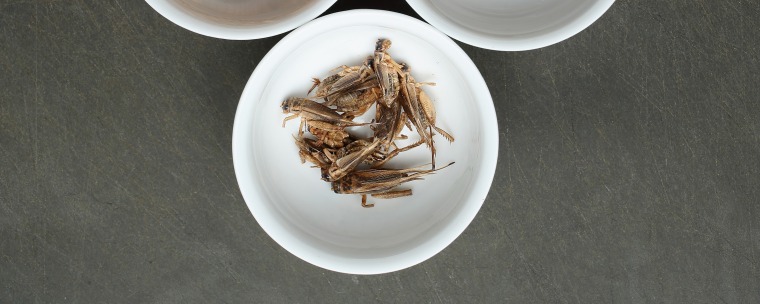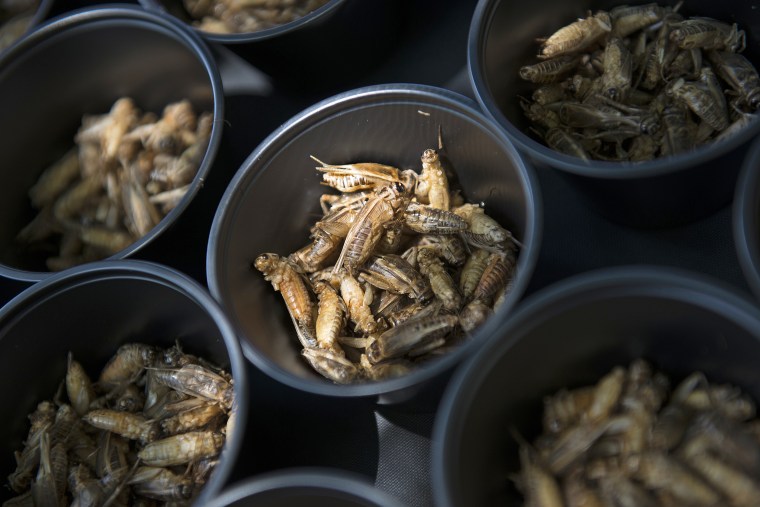If You Can't Beat Them, Eat Them : Queasy You?
"Insects have consumed something like one out of every eight loaves of bread before it even gets made."
"If we warmed four degrees, which is what climate models typically predict for the end of this century, then that amounts to insects eating two of our eight loaves of bread instead of one."
Curtis Deutsch, professor, University of Washington
"This online resource tells us that there are an estimated 10 quintillion insects on Earth. That's 10 followed by 18 zeros. Taking the Earth's human population at seven billion, that means there are 1,428,571,428.57 insects for every person on the planet. Let's round it out to say there are about 1.4 billion insects for every human. (Incidentally, this doesn't include spiders, because they're arachnids, not insects.)""This got us wondering about approximately how much humanity is outweighed by all those little critters. So we did the following, very rough calculation: Assuming the weight of an average insect is 3 milligrams (as is the case with ants) and the average weight of a person is 60 kilograms, then the weight of the world's insect population is about 70 times that of its human population."
Collected Wisdom, The Globe and Mail, Toronto
 |
In a warming climate on this planet of ours, insects multiply. Warming makes them hungrier, and shortens their lifespan, while instigating them to then reproduce at a faster rate. Not that we really notice yet, or that we've lately been overcome with their presence. Give it time. And more warming. Doubtless science will consider what solutions may exist to discourage all those insects from depriving humans of agricultural crops required to keep us alive, and which just incidentally keep those pests alive, as well.
One solution may be: humans eat insects. Many already do. Just not in the West, so much.
Globally an estimated two billion people regularly consider insects a vital and delicious part of their daily diet. In Peru for example, Amazonian weevil grubs sprinkled with palm oil and then caramelized to a turn charred over a fire is to die for. Which is to say, the grubs die for the purpose of feeding appreciative humanity. And while in Peru this may be standard and considered delicious it has yet to make its way onto plates regularly in Europe and North America. But wait, once word gets out that this type of diet is really cool, it may take off.
 |
| Courtesy of Ramen Nagi Insect Ramen, Ramen Nagi, Japan |
Eventually the West may consider that locusts simmered in tsukudani represents a sublime sweet-and-salty snack, just as they do in Japan. The appetite lacking for these delicacies in the West may just be turned around with the right publicity and public relations to convince people that this represents the ultimate in haute cuisine. Eventually a plate of hexapods or a bowl of larvae may join the fine dining repertoire of exalted French restaurants.
In fact, that transition may have already started. In the United States last year, Americans spent over $55 million on edible insects, proof-positive that palates are amenable to succumbing to curiosity, exploration and change. The health and environmental benefits of entomophagy is being extolled as a responsible and delicious way to fill one's mouth and belly. Baked products relying on flour milled from roasted and pulverized crickets (gluten-free!) have gained in popularity in places like (where else?!) Silicon Valley.
 |
"The most iconic ingredients in Mexico" are served at Quintonil, boasts chef Jorge Vallejo; avocado and insects. "When people come to Mexico, they're always curious about eating insects, because in our culture, it's part of the everyday." As for the taste of escamoles, Mr. Vallejo compares them to caviar with a nutty, grassy flavour; their texture has been described as that of a marshmallow. That pique your gustatory interest?
 |
Cricket, Mealworm, and Grasshopper Burger, Grub Kitchen, UK |
"We really don't use ingredients that are very expensive. The real value comes from the stories you can tell." Got that? The ingredients are readily sourced, and when they've been transformed into a colourful, spice-sheltered unidentifiable food, a sheen of delicate uniqueness blooms over them arousing a diner's sense of adventure, anxious to give them a try and then boast of the experience for which they were dinged a pretty penny.
 |
| Paul Wagtouicz Black ant guacamole, The Black Ant, NYC |
Labels: Gastronomy, Insects

0 Comments:
Post a Comment
<< Home